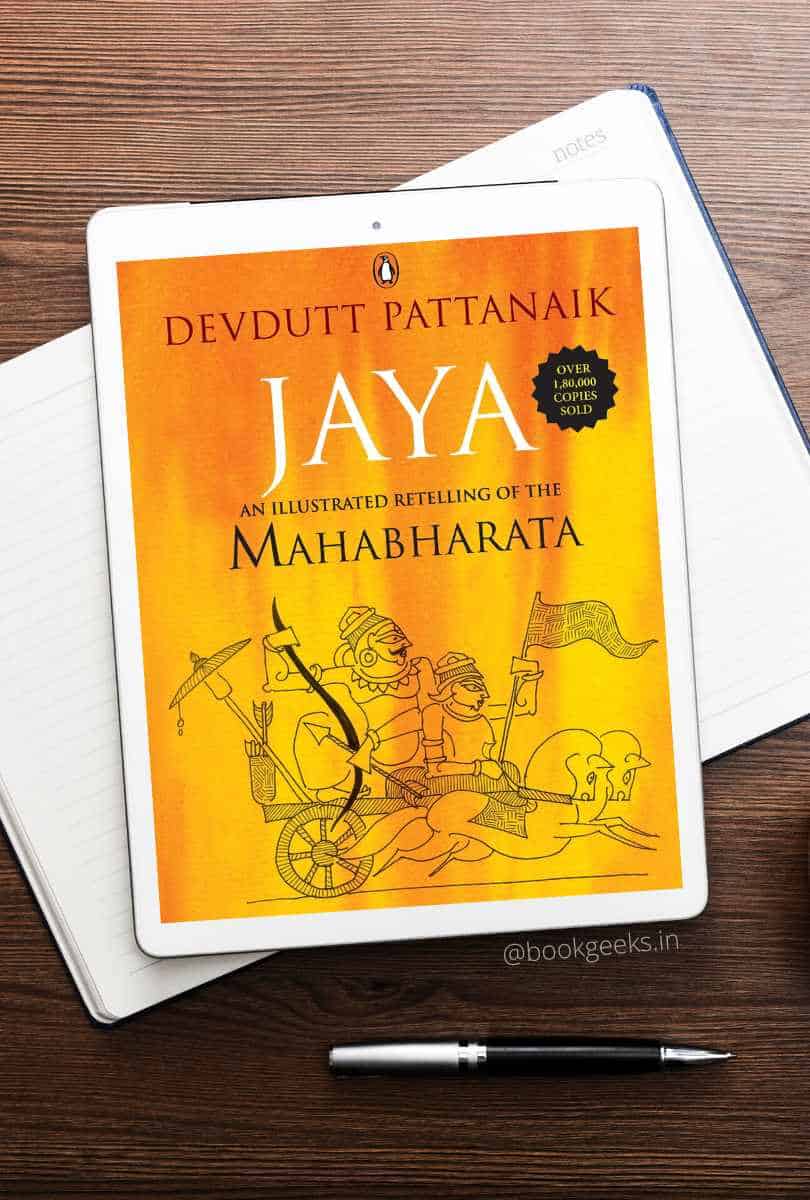SUBJECT: 4/5 RESEARCH: 2.5/5 WRITING STYLE: 3/5 OVERALL: 3/5 Themes: Mythological Retelling, Mahabharata, Illsutrated Retelling
“Everybody dies—some suddenly, some slowly, some painfully, some peacefully. No one can escape death. The point is to make the most of life—enjoy it, celebrate it, learn from it, make sense of it, share it with fellow human beings—so that when death finally comes, it will not be such a terrible thing.”
– Devdutt Pattanaik, Jaya: An Illustrated Retelling of the Mahabharata
Long ago, Lord Krishna imparted invaluable life lessons in preparation for the grand war, the Mahabharata. Remarkably, these teachings continue to hold relevance even today and can be seamlessly integrated into our daily lives.
It is known that every tale can be seen from a distinct and contemporary standpoint. Jaya: An Illustrated Retelling of the Mahabharata, authored by Devdutt Pattanaik, presents precisely that fresh perspective on the epic saga.
This retelling breathes new life into the timeless narrative, offering a new voice and vision to its enduring legacy.
To fully grasp the perspective presented in this book, it is crucial to possess a profound comprehension of the original Mahabharata narrative. Without prior knowledge of the story, individuals may struggle to appreciate its nuances.
However, thanks to the accessible language employed by the author, even those unfamiliar with the tale can readily grasp the author’s ideas and interpretations.
Furthermore, the book’s captivating cover adds to its appeal. For enthusiasts of mythological fiction stories, this book undoubtedly merits a place on their to-read list.
Through this retelling, readers are invited to delve into the profound meanings of life and spirituality embedded within the stories.
“Krishna offers Arjuna two things: what he is and what he has. Arjuna chooses what Krishna is. Duryodhana is happy with what Krishna has. This divide between him and his, me and mine, what one is and what one has, is the difference between seeking the soul and being satisfied with matter.”
The author’s approach offers a renewed understanding and appreciation of these narratives, enriching the reader’s exploration of many timeless themes.
Within the pages of Jaya: An Illustrated Retelling of the Mahabharata, Devdutt skilfully presents Ved Vyasa’s rendition of the Mahabharata, and in this, one prominent concept explored is that of Jaya and Vijaya.
Vijaya signifies materialistic triumph, while Jaya represents spiritual victory—an essential dichotomy brought to light within the narrative.
Furthermore, the book is adorned with captivating illustrations that enhance its allure. These beautiful visuals add an extra layer of intrigue, making the reading experience all the more captivating.
The stories within the book are not presented in lengthy chapters but rather in concise lines or paragraphs, making them remarkably accessible and easier to comprehend. This formatting choice allows readers to grasp the essence of each story swiftly and effortlessly.
By breaking down the narratives into smaller, digestible portions, the book facilitates an easy reading experience.
While Jaya: An Illustrated Retelling of the Mahabharata offers a spiritual perspective, the life lessons shared by the author extend beyond the realm of spirituality and can be applied to achieve success in the materialistic world.
This book caters to the aspirations of those who embrace spirituality while also providing essential guidance for navigating both personal and professional spheres.
The author skilfully explores the concept of being victorious in the spiritual realm (Jaya) and achieving success in the materialistic world (Vijaya).
Drawing a captivating connection between these two aspects of life, the author weaves a beautiful narrative that elucidates their interdependence.
Within the book, readers will discover an exploration of how these two dimensions influence and shape one another, offering an understanding of the intricate relationship between spirituality and material pursuits.
Taking a critical stance on this intriguing read, I find it necessary to highlight the writer’s limited approach to interpretation and retelling.
Some incidents are treated with a hint of casualness, and one could argue that they lack depth, focusing more on surface-level elements rather than exploring profound understanding.
Pattanaik’s myths, it appears, are tailored more for entertainment rather than a comprehensive grasp of the underlying narratives.
While the book may offer recreational value to beginners, it is important to note that it shouldn’t be considered an authoritative source or an exhaustive interpretation of the original text.
Can’t wait to read it? Buy your copy of Jaya: An Illustrated Retelling of the Mahabharata using the link below.
